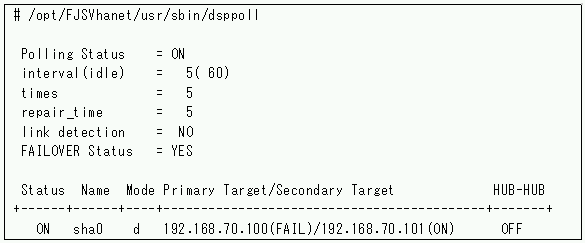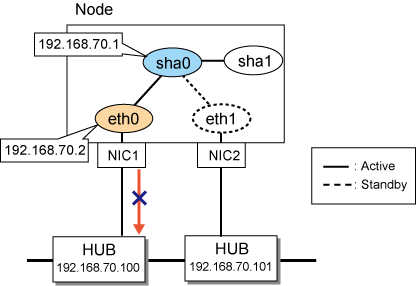Symptom:
The following messages (*1) are output to the system log, and the switch of NIC occurs.
hanet: ERROR: 87000: polling status changed: Primary polling failed. (eth0,target=192.168.70.100) |

*1) When using the second NIC as an active NIC, "Secondary polling" will be output instead of "Primary polling".

Corrective action:
Run the ping in specified monitored targets and monitoring the transmission path by NIC switch methods. When the communication failure of ping was detected, this message was output and NIC was switched. Please confirm the following items.
Switch occurs during importing/constructing changes
Since settings of the GLS and errors of network structure caused a lot of switches during importing/ composing changes, please confirm the following items.
Confirmation item | |
|---|---|
Cable | Connection confirmation |
Category | |
GLS settings | Settings of monitored targets |
Settings of monitoring parameters | |
Netmask settings | |
HUB settings | Confirmation of STP settings |
VLAN-ID | |
Network status | Communication load |
System log | |
Settings of the own node | IP filter |
Settings of network address | |
IP address | |
When switch occurs in operation process
Since a lot of switches are caused by abnormal transmission path, confirm the following items.
Confirmation item | |
|---|---|
Cable | Connection confirmation |
Category | |
HUB settings | Confirmation of communication mode |
Qos | |
Network status | Confirmation of maintenance working status |
Communication load | |
HUB status | |
System log | |
GLS settings | Settings of monitored targets |
Detail of each confirmation item is as follows.
Confirmation item | Contents | |
|---|---|---|
Cable | Connection confirmation | 1) Cable may be disconnected. Please confirm that the cable is connected with the node and HUB. |
Category | 1) Confirm whether the category (straight cable, cross cable) used by cable is correct. In addition, if the communication mode is not set to auto negotiation, the function (Auto-MDIX) of automatic cable category identification will be invalid. For details, refer to the HUB manual. | |
GLS settings | Settings for monitored targets | When the IP address of HUB that is the monitored target is different from the one defined as monitored target, failure of monitoring will occur and switch will be performed. Please confirm whether the two IP addresses mentioned above are in accordance by the hanetpoll command. |
Settings for monitoring parameters | The monitoring by ping is set to judge an abnormal transmission path when continuously failing five times every five seconds in default. When the parameter is set too short, incorrect switch (Incorrect switch still occur even if the transmission path is correct) may occur. When incorrect switch occurs frequently, please increase the monitoring time for transmission path anomaly. | |
Netmask settings | When Netmask settings are incorrect, communication may fail. Please confirm Netmask is set by the ifconfig command. Confirm that the settings have completed by the hanetmask command. | |
HUB settings | Communication mode | Please confirm whether the communication mode set to the port of the interface matches that of HUB. When the communication mode of the HUB is different from that of the own node, the collision might result in the packet lost frequently. (For example: When setting the own node to auto negotiation and setting HUB to fixed full duplex) In addition, the following communication modes are required among the computers connecting with the Ethernet. |
STP settings | The communication will be disabled for about 30 seconds after the activation of the interface of GLS and the switch when STP (spanning tree protocol) becomes valid. During this period, the GLS suppresses the switch of NIC due to the failure of the HUB monitoring. Set the controlled time by the hanetpoll command as the parameter "Time of delay for Linking Up" (60 seconds in default). Incorrect switch of NIC may occur if this parameter value is small. Processing it in the following methods. 1) Change the parameter settings to prevent incorrect switch. 2) Invalidate STP of used HUB port in the network where the transmission of packet does not form loop. | |
VLAN-ID | Errors may occur in VLAN-ID settings. Confirm whether the following VLAN-IDs are in accordance. | |
QoS | When setting a low priority for ping in the QoS (Quality of Service) settings of HUB, the ping response from HUB might be delayed in network with a high load. In this case, switch of NIC may occur even if the transmission path is in correct. Please check the settings of QoS. | |
Network status | Maintenance work | Please confirm neither the reactivation of the monitored targets HUB nor the maintenance work of the exchange, etc, are done during the period of switch. In addition, when changing the monitored targets HUB, the HUB must be changed after the HUB monitor is stopped. |
Communication load | The delay and the packet lost of Ping may be caused by temporary high communication traffic of the network during the period of switch. Please confirm whether there are conflict and packet loss from the statistic information and logs of HUB. Please confirm the amount of received and sent packets etc. by the sar command in Linux environment. In addition, in the environment where the network with different types of speed (1Gbps and 100Mbps, etc.) exists, even if the unoccupied bandwidth exists in a high-speed network, the packet may still be lost when transferring from the HUB to a low-speed network. Please confirm whether the traffic has been estimated correctly. | |
HUB status | Errors may occur in HUB and the power supply may be cut off. Please confirm whether the link down message has been output to the system log. Packet might loop when errors occur in HUB, confirm whether a conflict has occurred by the netstat command. Moreover, when setting HUB monitoring function of a monitored target excluding adjacent HUBs, the cable connected with HUB and the monitored target may be disconnected. | |
System log | 1) The NIC that monitors HUB might have been linked down. Please confirm whether the link down message has been output to the system log during the period of switch. | |
Settings for the own node | IPfilter | The IP packet to the interface used by the GLS might be filtered. Please confirm the setting of the firewall when you filter IP, and set that packets of ping can pass the firewall. |
Setting of network address | Please run the netstat -rn command to confirm that there is no virtual IP address of GLS same as transmission path of network. When the network is overlap, transmission of ping cannot be done by a correct path (HUB monitoring). Therefore, NIC switch cannot be performed when faults occur in the transmission path used by the GLS. Conversely, switch will occur when faults occur in the transmission path that has not been used by the GLS. Please check settings of IP address and netmask. In addition, confirm that there is no more than 3 NICs have been connected on the same subnet in the network structure (more than 2 types of structures of NIC combination that is bound with the virtual interface are in one subnet). Please check the construction in certain conditions. | |
IP address | Please confirm that the IP address set in the own node is different from the ones set in other nodes. When the IP address is repeated, the response of ping from communication target is sent to the node address whose node is different from the transmission source node, and unable to communicate sometimes. In this case, the HUB monitor fails. | |